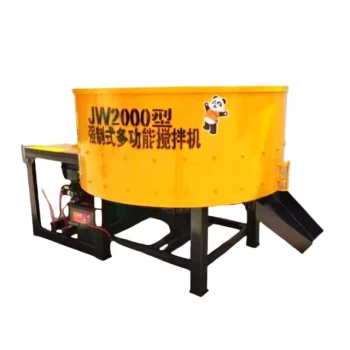A concrete block machine works by mixing cement, aggregates, and water to form a uniform mixture, which is then compressed under high pressure to create solid or hollow blocks without the need for burning. The process involves precise proportioning of materials, thorough mixing, and molding under pressure to ensure durability and consistency in the final product. Key components include mixers, hoppers, conveyors, and a pressing mechanism, all controlled by an automated system for efficiency and accuracy.
Key Points Explained:
-
Material Proportioning and Feeding
- The process begins with feeding raw materials like cement, sand, aggregates, and water into individual bins or hoppers.
- These materials are weighed or volumetrically proportioned to ensure the correct mix ratio, which is crucial for block strength and quality.
- Example: Volumetric batching is common in mobile mixers, while weigh batching is used in stationary plants for higher precision.
-
Mixing Process
- The materials are transferred to a mixer (e.g., twin-shaft or drum mixer) where they are blended uniformly.
- The mixing time is controlled by an automated system to achieve a homogeneous consistency.
- Ever wondered how the mixer prevents cement from caking? The rotating action ensures even distribution without settling.
-
Molding and Compression
- The mixed concrete is fed into molds in the concrete machine, where it is compressed under high pressure (up to hundreds of tons).
- This compression eliminates air pockets and ensures dense, durable blocks.
- Hollow blocks are formed using molds with cores, while solid blocks use simpler molds.
-
Curing and Demolding
- Unlike traditional brick-making, concrete blocks don’t require firing. Instead, they cure naturally or in controlled environments.
- After initial setting, blocks are demolded and stacked for further curing, gaining strength over time.
-
Automation and Control
- Modern machines feature PLC-controlled systems for precise operation, from batching to pressing.
- Sensors and conveyors streamline material flow, reducing manual intervention.
-
Types of Machines
- Stationary Plants: Large-scale production with fixed setups, ideal for high-volume output.
- Mobile Units: Portable mixers and presses for on-site block production, offering flexibility.
-
Final Product Handling
- Finished blocks are transported via conveyors or pallets for storage or direct use in construction.
- Quality checks ensure dimensional accuracy and compressive strength meet standards.
By integrating these steps, concrete block machines transform raw materials into reliable building components, powering infrastructure projects worldwide. The balance of precision engineering and automation makes them indispensable in modern construction.
Summary Table:
| Step | Key Process | Purpose |
|---|---|---|
| Material Proportioning | Cement, sand, aggregates, and water are precisely measured. | Ensures consistent block strength and quality. |
| Mixing | Materials are blended uniformly in a mixer (twin-shaft or drum type). | Achieves homogeneous consistency for even compression. |
| Molding/Compression | Concrete is pressed into molds under high pressure (up to hundreds of tons). | Eliminates air pockets; forms dense solid/hollow blocks. |
| Curing/Demolding | Blocks cure naturally or in controlled environments; no firing needed. | Enhances durability and strength over time. |
| Automation | PLC-controlled systems manage batching, mixing, and pressing. | Improves efficiency, precision, and reduces manual labor. |
Upgrade your construction projects with high-performance machinery—contact us for durable Garlway winches and concrete block machines tailored to your needs!
Related Products
- Portable Concrete Mixer Machine Equipment for Mixing Concrete
- Construction Products Concrete Plant Machine Mixing Concrete Mixer
- Concrete Cement Mixer Machine Drum Mixer for Construction
- HZS25 Best Cement Mixer for Quick Mix Concrete at Bunnings
- Ready Mixer Machine for Construction Ready Mix Machinery
People Also Ask
- What are the factors influencing choice of a concrete mixing plant? Key Considerations for Optimal Performance
- How long does it take to mix concrete in a portable mixer? Optimize Your Mixing Time
- How much concrete can you pour with a portable mixer? Maximize Small-Scale Efficiency
- What are the components of concrete mixing? Essential Ingredients for Strong Structures
- How much concrete can you mix in a portable mixer? Maximize Efficiency for Your Projects



















